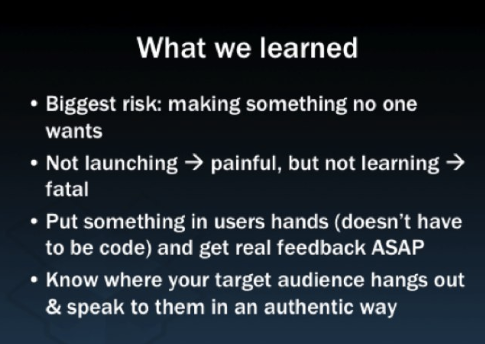A minimum viable product (MVP) helps entrepreneurs test and validate a business idea as quickly as possible. It allows individuals to learn, gain feedback and start attracting early adopters.
Don’t know what your MVP should look like? Take inspiration from these 5 infamous MVPs…
Check out our free resource on developing your own MVP.
What if my idea is complicated and needs bespoke technology?
Then maybe you don’t need to build anything at all!
Drew Houston (CEO of Dropbox) knew that his idea was going to be hard to simplify and would take a great deal of time and money to create. Because of this, the Dropbox team decided to pretend like they had made their product and demoed it in a video.

This simple 3-minute video shows what Dropbox is and how it works. After this video was released, thousands of people went to the Dropbox website and signed up to the beta waiting list – they went from 5,000 people to 75,000 in just one night!
Drew summarizes his MVP lesson in one slide:

I am creating a physical product and want to know if people will actually buy it… But building only one is too expensive to test!
Pebble was a smartwatch that connected to smartphones to deliver notifications. They famously raised $10.3 million on a crowdfunding platform (Kickstarter) between April and May 2012. The people who invested in Pebble were promised a watch once the funding goal was reached, effectively meaning they had $10.3 million worth of pre-orders before their product was even built!
This was a fantastic way to prove the demand for a physical product whilst actually generating money for the business too.
Free report: From idea to MVP – how to validate your business idea
I can see a future market trend, but I’m not sure what my product should be
Jeff Bezos read a report that projected annual web commerce growth at 2,300%. He decided to write a list of 20 products that he thought could be marketed online. He narrowed down the list to five products such as hardware, videos and books. He finally settled on selling books online because of the demand for literature and their low price point.
The Amazon MVP was created: It was a simple website that showed a catalogue of books customers could buy online. As web commerce grew, so did Amazon to become the giant is today.
My idea has many core features, I need a team to build my MVP!
Does it need to have that many features though?
Spotify decided to focus on its main core feature instead of getting distracted by the “nice to have” features. They wanted to create the best ever music streaming service so… they built something that could only stream music! Their MVP and freemium model proved to be what the market wanted and was enough to validate their idea.

Shouldn’t my business be scalable?
Andrew Mason had a website called ‘The Point’ that connected individuals together: It wasn’t gathering much momentum. They decided to create a blog on the site called ‘The Daily Groupon’ and started to post deals on the WordPress blog manually each day. When someone signed up for the deal, the team would email a PDF document to them manually. As you can imagine, the process of creating PDFs and sending them to a mailing list isn’t what you call scalable!
This said, the blog proved to Andrew that there was a demand for coupon codes and that this idea could become a business. An MVP is for validating ideas, not scaling a business.
Enjoy this article? Check out our free resource on developing your own MVP.